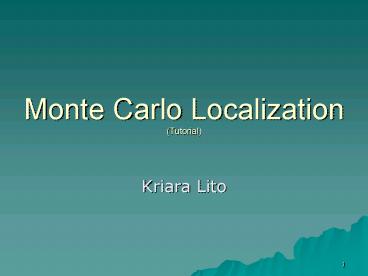Monte Carlo Localization Tutorial - PowerPoint PPT Presentation
1 / 25
Title:
Monte Carlo Localization Tutorial
Description:
Monte Carlo localization (MCL) is a Monte Carlo method to determine the position ... A. Doucet, 'On sequential simulation-based methods for Bayesian filtering', Tech. ... – PowerPoint PPT presentation
Number of Views:896
Avg rating:3.0/5.0
Title: Monte Carlo Localization Tutorial
1
Monte Carlo Localization (Tutorial)
- Kriara Lito
2
Introduction
- Monte Carlo localization (MCL) is a Monte Carlo
method to determine the position of a robot given
a map of its environment based on Markov
localization. - implementation of the Particle filter
3
Initialization
- Random initialization of configuration space
- Like in particle filters method
4
Probability update
- With each sensor update, the probability that
each hypothetical configuration is correct is
updated based on a statistical model of the
sensors and Bayes' theorem.
5
Re-initialization
- When the probability of a hypothetical
configuration becomes very low, it is replaced
with a new random configuration.
6
Comparison with particle filters
- In each iteration there is a conditional
probability (Bayes Theorem) given the prior
position of the user.
7
Algorithm 6
- Density
- by a set of N random samples / particles
- Prediction Phase The predictive density over xk
is then obtained by integration - Update Phase
- use a measurement model to incorporate
information from the sensors to obtain the
posterior PDF - We assume that the measurement is
conditionally independent of earlier measurements
given , and that the measurement model
is given in terms of a likelihood - The posterior density over xk is obtained using
Bayes theorem - The process is repeated recursively
8
Monte Carlo method(Tutorial)
- Lito Kriara
9
Introduction
- Monte-Carlo algorithms always return a result,
not an approach of the exact solution. - The result of a Monte Carlo method may not be
correct, but the probability of the algorithms
success increases proportionally to its
execution time.
10
Introduction
- Class of computational algorithms that rely on
repeated random sampling to compute their results
- They rely on repeated computation and random or
pseudo-random numbers - used when it is infeasible or impossible to
compute an exact result with a deterministic
algorithm
11
Goal
- Derive algorithms that, starting from some
initial value and applying iterative methods,
produce a sequence that - It is unpredictable for the uninitiated (relation
with Chaotic dynamical systems) - It passes a battery of standard statistical tests
of randomness (like Kolmogorov-Smirnov test,
ARMA(p,q), etc).
12
Example
- player makes random shots
- player applies algorithms
- player can determine likely locations of other
player's ships - based on outcome of
- random sampling
- algorithm
13
Monte Carlo methods pattern
- Define domain of possible inputs
- Generate inputs randomly from domain
- perform deterministic computation on them
- Aggregate results of individual computations into
final result
14
- Examples of Monte Carlo use
15
Difficult to even approximate
16
Classical Monte Carlo Integration
- Assume we know how to generate draws from
- What does it mean to draw from ?
17
Basic Component
- Multiplicative Congruential Generator
- xi takes values on 0, 1, ...,M
- Transformation into a generator on 0, 1 with
- x0 is called the seed
18
Choices of Parameters
- Period and performance depends crucially on
- a, b, and M
- Pick a 13, c 0, M 31, and x0 1
- Let us run badrandom.m
- Historical bad examples
- IBM RND from the 1960s
19
A Good Choice
- A traditional choice
- a 75 16807, c 0, m 231 - 1
- Period bounded by
- M. 32 bits versus 64 bits hardware
20
Real Life
- Code your own random number generator
- Matlab implements such functions
- http//stat.fsu.edu/pub/diehard/
21
Example - Acceptance Sampling
- ? with support C,
- is called the target density
- z g (z) with support C ? C,
- g is called the source density
- We require
- We know how to draw from g
- Condition
22
Acceptance Sampling Algorithm
- Steps
- u U(0, 1)
- If return to step 1.
- Set
23
(No Transcript)
24
Conclusion
- Monte Carlo method is a basic idea (slide 5)
transformed according to the context used each
time. - Such a transformation is for localization issues
- Monte Carlo Localization
25
References
- http//en.wikipedia.org/wiki/Monte_Carlo_localizat
ion - http//en.wikipedia.org/wiki/Monte_Carlo_method
- http//www.chem.unl.edu/zeng/joy/mclab/mcintro.htm
l - http//www.econ.upenn.edu/jesusfv/LectureNotes_5_
montecarlo - A. Doucet, On sequential simulation-based
methods for Bayesian filtering, Tech. Rep.
CUED/F-INFENG/TR.310, Department of Engineering,
University of Cambridge, 1998. - F. Dellaert, D. Fox, W. Burgard and S. Thrun,
Monte Carlo Localization for Mobile Robots,
IEEE International Conference on Robotics
Automation, 1998

